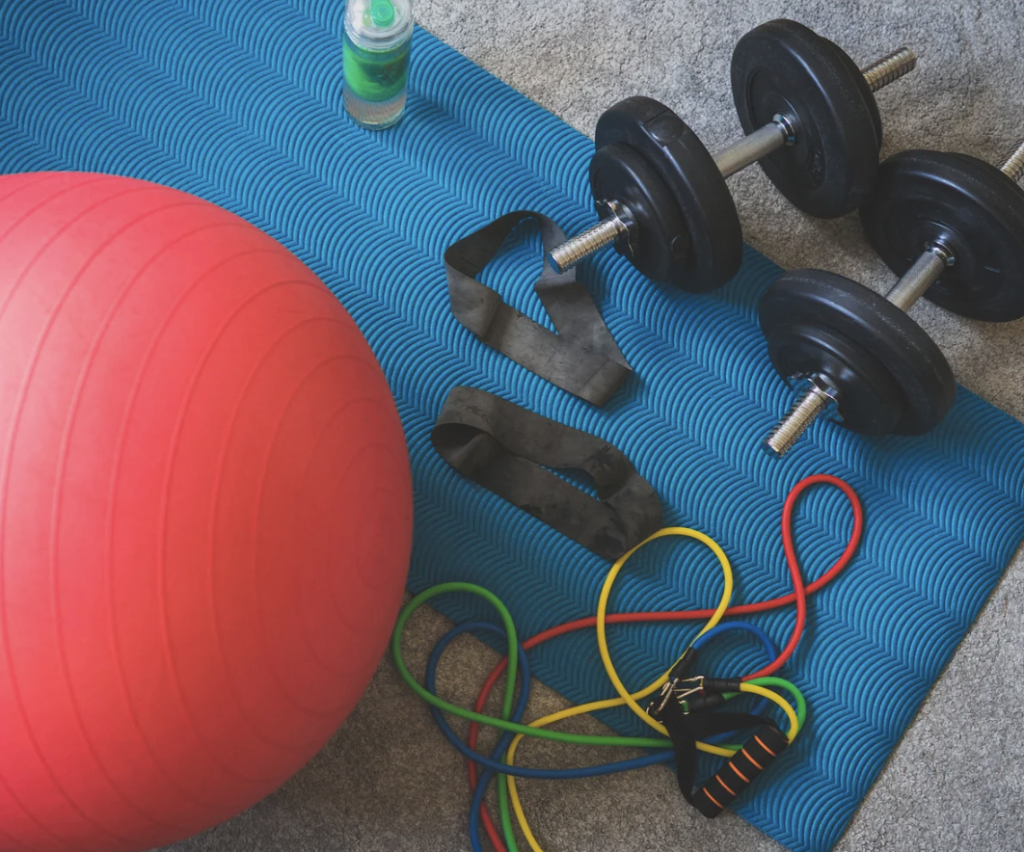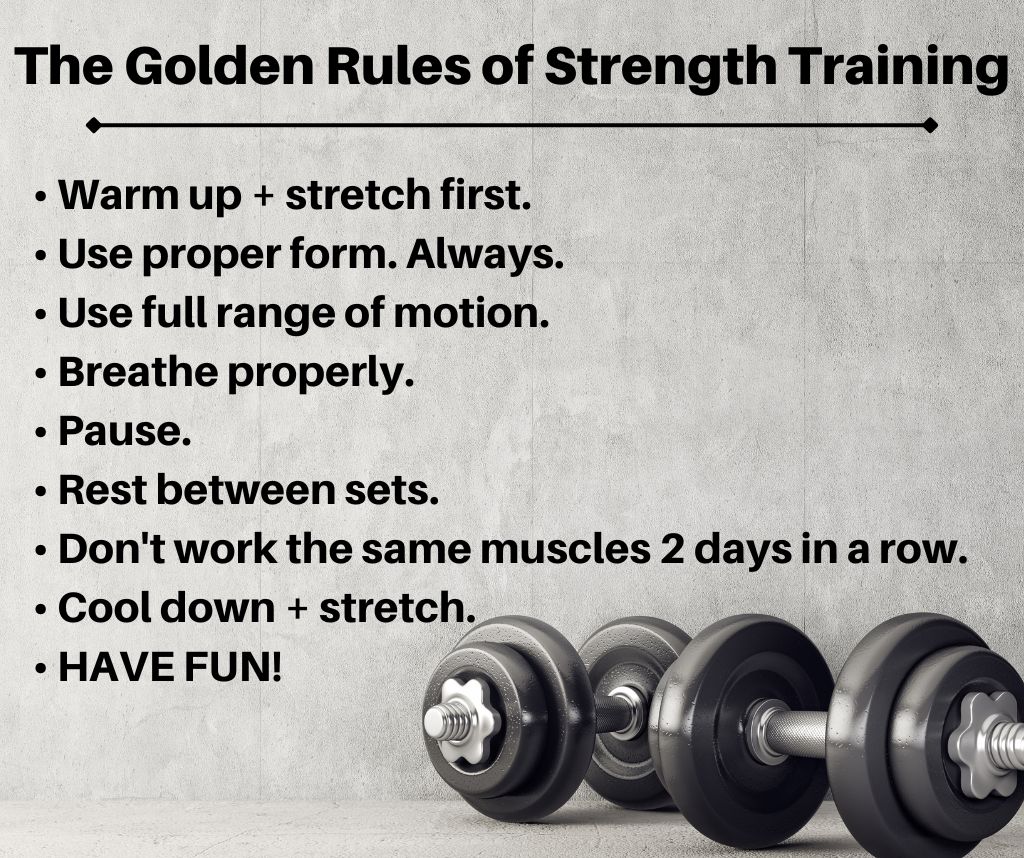Strength training is an integral part of a successful workout program. I shared why it’s important as well as some basic things about strength training last week, and you can read that post here. In this second post, I’m sharing some important tips and guidelines to not only make strength training as easy as possible to fit into your already busy schedule but also some guidelines to help you work those muscles as safely as possible and achieve the strength goals you’re aiming for.
The Golden Rules of Strength Training
Any time you do a strength training session, there are some important things to keep in mind to ensure that every session is both safe and productive. You might as well make the most of that valuable time, right? I’ve even made these rules into a handy graphic you can save so you can use them while you’re strength training!
Warm up and stretch first. Cold muscles do not work out well, and they’re also more prone to injury. So before beginning your workout, warm up for a few minutes—5 minutes works great, and then at least lightly stretch the muscle groups you’ll be using. It never hurts to do a full body stretch either!
Use proper form. Always. This is the MOST important thing to remember. When you don’t use proper form, you WILL get injured. That’s a promise. If you’re unsure of how to do any movement, I found an app—iMuscle 2—that’s available on both apple and android that gives great explanations on how to do many strength training exercises, including which muscles you’re working.
Use full range of motion. When doing any movement, make sure to move the muscles as far as possible comfortably, working the entire muscle. If the entire muscle isn’t worked, that muscle can be shortened and your everyday movement can be affected, potentially resulting in decreased flexibility and strength, which can possibly cause an injury.
Breathe properly. Do not ever hold your breath while doing a strength training exercise! Here’s how to make the best use of your breathing while strength training: Exhale on the hard part, inhale on the easy part. Take it one step farther and count while you breathe, which will also make sure you’re doing the movements safely (not too quickly). Here’s what that looks like:
- Count to 2 or 3 during the hard part (when you are fighting against gravity), then count to 4 or 6 on the easy part (when you’re not fighting against gravity).
Why that last tip? It’s easy to let momentum take over on the easy part, but when you do this, you’re missing out on some valuable strength training on the muscles opposite of the ones you’re working. For example: When doing a bicep curl, count to 2 or 3 as you bring the weight towards your shoulders, then count to 4 or 6 as you lower the weight. You’ll be strengthening the bicep first, then the tricep (the opposing muscle) second. That’s a two-for-the-price-of-one movement!
Pause. Make sure to pause for just a second or two at the end of each movement. For example, when you do a bicep curl, pause before lowering the dumbbell and then again before lifting it. Why? This pause alleviates any momentum, which can actually make the movements easier, decreasing the positive effects you’re going for. This pause will also help you have better control over the movement, helping to reduce your risk of injury. Next time you’re at the gym, watch those around you. Are they pausing? Or are they using momentum to make the movement easier?
Rest between sets. It’s important to let your muscles take a breather between sets so they can recover and get ready to move again. If you don’t rest your muscles adequately between sets, your workout won’t be as effective and you’ll be more prone to injury. How long should you rest between sets?
- If your goal is muscle endurance, rest for 20-60 seconds between sets.
- If your goal is muscle strength, rest for 30-90 seconds between sets.
- If your goal is maximum muscle strength + power, rest for 2-5 minutes between sets.
- If you’re a strength training newbie OR you haven’t done strength training in a while, rest for 60-120 seconds between sets.
Another idea to save time is to do an upper body movement followed by a lower body movement and skip the rest period. Your upper body will be “resting” while you’re doing the lower body movement and vice versa.
Don’t work the same muscle group(s) two days in a row—only work the same muscle group(s) every 48 hours. When you work those muscles, tiny tears are created in the muscles, which is a good thing. It takes 48 hours for those tears to heal and make those muscles even stronger, so your muscles need that 48 hours of rest!
Always cool down and stretch when finished. Again, 5 minutes works here too. Do some gentle movement for 5 minutes, and then do a whole body stretch.
Have fun! This is also one of the most important rules to follow because if you’re not having fun doing something, you probably won’t be consistent, and consistency is key when strengthening your beautiful muscles. So if you find yourself getting bored or wanting to skip a workout, try adding some variety to what you’re doing. If you don’t have dumbbells or want to change up your workouts, try resistance bands (see my favorites here, here, and here). They’re travel-friendly too, making it possible to do your workouts anywhere. Stability balls can also be useful. Do wall ball squats, use them as a weight bench (which also helps increase your balance), and so on. If you just can’t seem to have fun, always remember that you’ll be so grateful when your workout is over.
I used to not be a fan of strength training until I just decided to do it, and now I actually enjoy it. Yes, there are some days I want to skip it (who doesn’t have those days?!), but like I shared in that last tip, I’m always grateful I did it when I’m done. And knowing that my muscles are getting stronger and will be able to help me do all the things I want to do now and for decades to come is a pretty great motivator too.







Leave a Reply